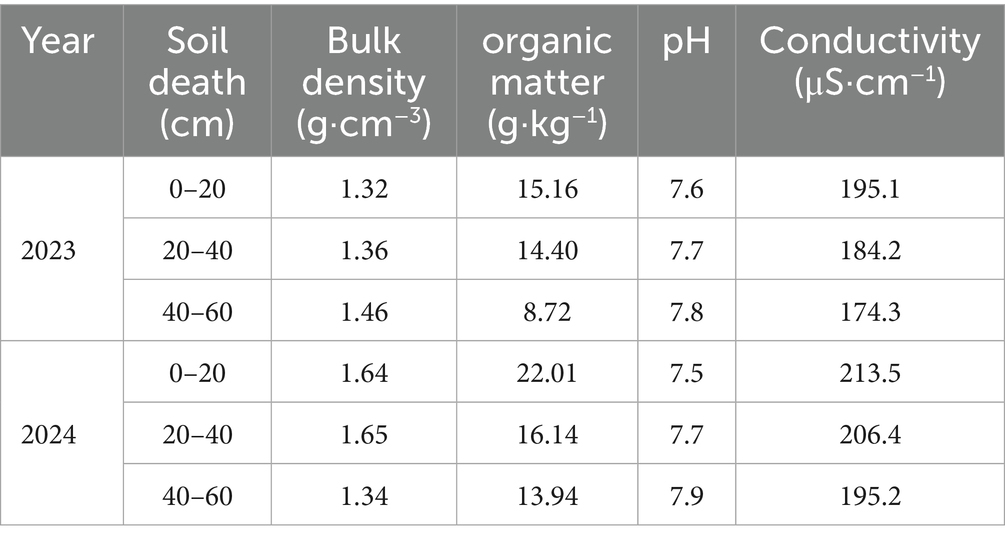- 1Department of Agriculture, Shihezi University, Shihezi, Xinjiang, China
- 2Xinjiang Production and Construction Corps 7th Division Institute of Agricultural Sciences, Kuitun, Xinjiang, China
In arid Xinjiang, high crop yields depend on substantial water and nitrogen inputs, but this leads to inefficient resource use. This study investigated whether water and nitrogen inputs could be reduced without compromising yield in post-wheat relay-cropped soybean, aiming for more efficient resource utilization. In 2023 and 2024, a field experiment was conducted at the Experimental Station of the College of Agriculture, Shihezi University. The experiment employed a two-factor split-plot design, with irrigation amount as the primary factor with three levels: W1 (3,360 m3·hm−2, 33.3% reduction from W3), W2 (4,200 m3·hm−2, 16.6% reduction from W3), and W3 (5,040 m3·hm−2, conventional irrigation). Nitrogen application rate (pure nitrogen) was the secondary factor with four levels: N1 (0 kg·hm−2), N2 (105 kg·hm−2, 46.2% reduction from N4), N3 (150 kg·hm−2, 23.1% reduction from N4), and N4 (195 kg·hm−2, conventional application) – totaling 12 treatments. Among all treatments, only the water-saving (W2) and nitrogen-saving (N3) combination (W2N3) achieved agronomic traits, pod formation, and yield components statistically equivalent to conventional practice (W3N4). W2N3 maintained near-equivalent yield to W3N4 (reduction of 0.84–1.32%) while conserving water and N. This reduction lowers environmental risks (e.g., N leaching, salinity) and has the potential to improve soil health through optimized organic matter input. Economically, it reduced production costs by 483.91 CNY·hm−2, increasing net profit by 350.10–408.79 CNY·hm−2. Reducing irrigation by 16.6% and N by 23.1% optimizes resource efficiency, supports agricultural sustainability, and offers viable strategies for arid agroecosystems.
1 Introduction
Soybean is a significant oilseed and grain crop in China. Rising domestic demand has resulted in expanded cultivation, yet yield per unit area remains relatively low, making current production insufficient to meet market needs (Xu C. et al., 2020). Xinjiang possesses favorable solar-thermal resources. Post-wheat relay-cropping soybean systems have been proposed to enhance overall yields (Ran et al., 2023). The northern Xinjiang region remains conducive to crop growth after wheat harvest. The region’s abundant light and heat resources provide an efficiency advantage for post-wheat relay-cropped soybean systems (Wang et al., 2020).
The growth and development of crops is significantly influenced by water availability and nitrogen fertilizer (Hoffmann et al., 2021). A notable correlation exists between moisture and plant morphology (Desclaux and Roumet, 1996). Soybean plant height, stem thickness, chlorophyll concentration, and yield formation are all influenced by water application rates (Bellaloui and Mengistu, 2008; Jha et al., 2018; Sandoval-Villa et al., 2002). Optimal irrigation facilitates photosynthesis and grain-filling rates in soybeans (Cao et al., 2022). Water deficit inhibits plant growth, reduces chlorophyll content, and limits photosynthesis (Xu Q. et al., 2020). Excessive moisture induces exaggerated shoot elongation, redirecting dry matter allocation toward vegetative organs and impairing reproductive development, thereby suppressing soybean yield (Cheng et al., 2019; Li X. et al., 2021; Zeng et al., 2020). Nitrogen is an essential nutrient that facilitates chlorophyll and protein synthesis (Bellaloui et al., 2015; Kong et al., 2017). The formation of leaves, pods, and seeds is associated with the application of nitrogen fertilizer (Gai et al., 2017; Hou et al., 2022; Namvar et al., 2011; Noor et al., 2021). It has been demonstrated that Optimal nitrogen application enhances net photosynthetic rate, carbon assimilation, and grain formation, thereby increasing soybean yield. Excessive nitrogen application suppresses yield-related parameters and reduces nitrogen use efficiency (NUE) (Li et al., 2019; Zhang et al., 2020).
A substantial body of research confirms that water-nitrogen interactions synergistically enhance crop uptake and utilization of both resources, stimulate growth, and increase yields (Gonzalez-Dugo et al., 2010; Hammad et al., 2015; AlShamary et al., 2025). Research has found that optimal nitrogen application enhances agronomic trait development, photosynthetic parameters, and yield components (Hammad et al., 2012; Si et al., 2020); under certain nitrogen application levels, moderate drought enhances grain yield and nitrogen use efficiency (NUE) (Wang Z. et al., 2016). Under drought conditions, low nitrogen application reduces crop yield. Conversely, high nitrogen rates promote yield-related trait development, accelerate vegetative-reproductive transition, and enhance assimilate partitioning to economic yield components (e.g., grains) (Rathore et al., 2017).
The Xinjiang region experiences high temperatures and minimal precipitation, particularly during the months of July and August following the wheat harvest. This period is characterized by further aridity and water scarcity (Wan et al., 2022a). Applying 173 kg·hm−2 nitrogen to wheat enables subsequent cultivation of post-wheat relay-cropped soybeans at 69 kg·hm−2 N, achieving high yields in Xinjiang (Fu et al., 2020). In the context of production, however, the quantity of nitrogen applied to soybean crops is considerably higher than the figure of 69 kg·hm−2 (Che et al., 2021). Water insufficiency and excessive nitrogen application impede crop growth, reduce yields, and waste resources (Wan et al., 2022b). It has been established by related research that the implementation of water-saving and nitrogen-reducing measures has the potential to optimize both yield and resource utilization (Zhou et al., 2011). Consequently, assessing water-nitrogen reduction impacts on post-wheat relay-cropped soybean yield advances resource conservation, yield stability, and fertilizer optimization theories.
Current research on soybean growth under water-fertilizer regimes in arid regions is extensive. However, comprehensive studies on post-wheat relay-cropped soybeans in Xinjiang remain limited. To enhance yield, we recommend reducing water and nitrogen inputs. This study examines water-nitrogen coupling effects on agronomic traits, photosynthetic parameters, pod formation, and yield components. Our findings elucidate soybean responses to conservation measures, establishing a theoretical basis for optimized water-nitrogen management in northern Xinjiang relay-cropped systems.
The study objectives were to test: (1) Reduced water and nitrogen inputs improve relay-cropped soybean growth and photosynthetic capacity; (2) Reduced inputs promote pod and seed formation; (3) Reduced inputs increase yield.
2 Materials and methods
2.1 Biological material and field experiment
The experiment was conducted from April 2023 to October 2024 at the Experimental Station of the College of Agriculture, Shihezi University (44°18’N, 85°59′E). The site features a typical continental climate, with multi-year averages of 7.5–8.2°C temperature, 208 mm precipitation, and 1,660 mm evapotranspiration. The soil was irrigated tillage gray desert soil with a medium loamy texture. Figure 1 shows temperature and precipitation during July–October 2023. Basic physicochemical soil properties before sowing are presented in Table 1.
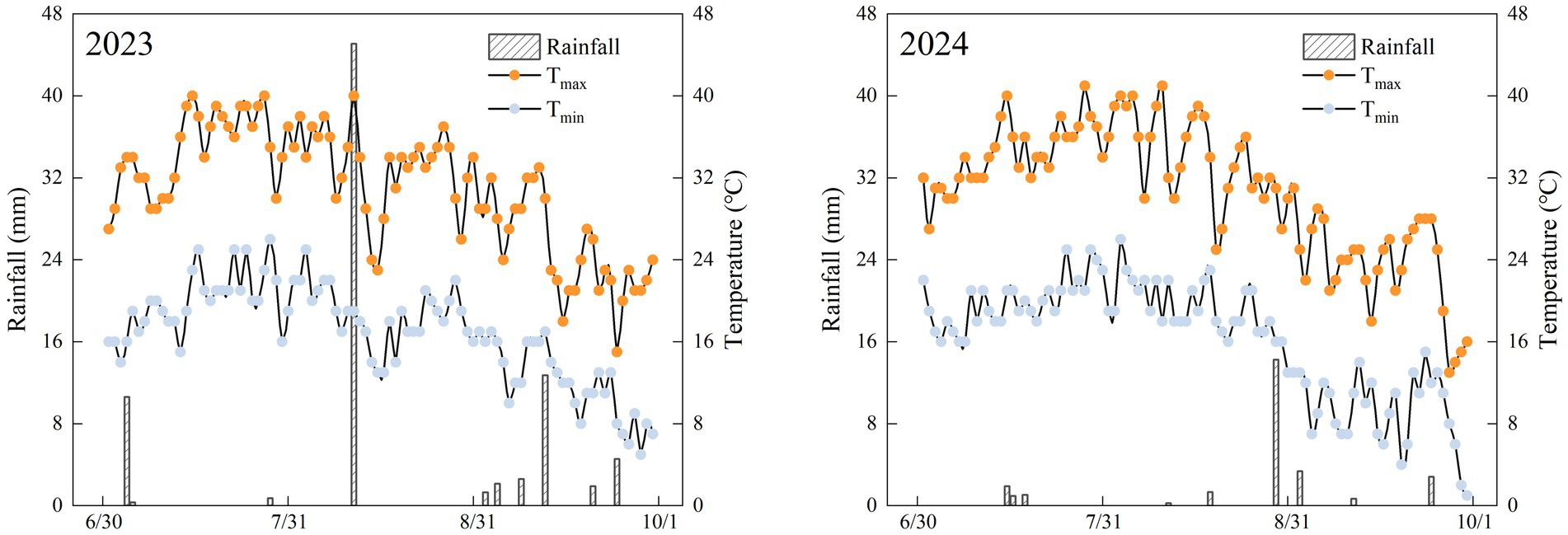
Figure 1. Daily precipitation and mean temperature during the 2023–2024 growing seasons. Dashed lines indicate monthly averages.
The experiment employed a two-factor split-plot design, with the primary factor being the amount of irrigation water, with three distinct irrigation levels established: The experimental units were designated as W1 (3,360 m3·hm−2, a reduction of 33.33% compared to conventional irrigation), W2 (4,200 m3·hm−2, a reduction of 16.67% compared to conventional irrigation), and W3 (5,040 m3·hm−2, representing the conventional irrigation); the secondary factor is the quantity of nitrogen applied (pure nitrogen), with four nitrogen application levels established: N1 (0 kg·hm−2), N2 (105 kg·hm−2, representing a 46.15% reduction compared to conventional), N3 (150 kg·hm−2, representing a 23.08% reduction compared to conventional) andN4 (195 kg·hm−2, conventional nitrogen application). All 12 treatments received uniform applications of P₂O₅ (102 kg·hm−2) and K₂O (69 kg·hm−2). Each treatment was replicated three times in 20 m2 plots (4 m × 5 m). The preceding spring wheat crop and subsequent relay-intercropped soybean (“Haojiang 35” variety) were established using no-till methods. Soybeans were planted at 30 cm row spacing and 5 cm plant spacing. Drip irrigation mirrored the spring wheat system, with one irrigation belt servicing four soybean rows. Eight irrigation events occurred at 7–10 day intervals during the growing season. Nitrogen fertilizer was applied via irrigation water in split doses according to treatment requirements (Table 2).
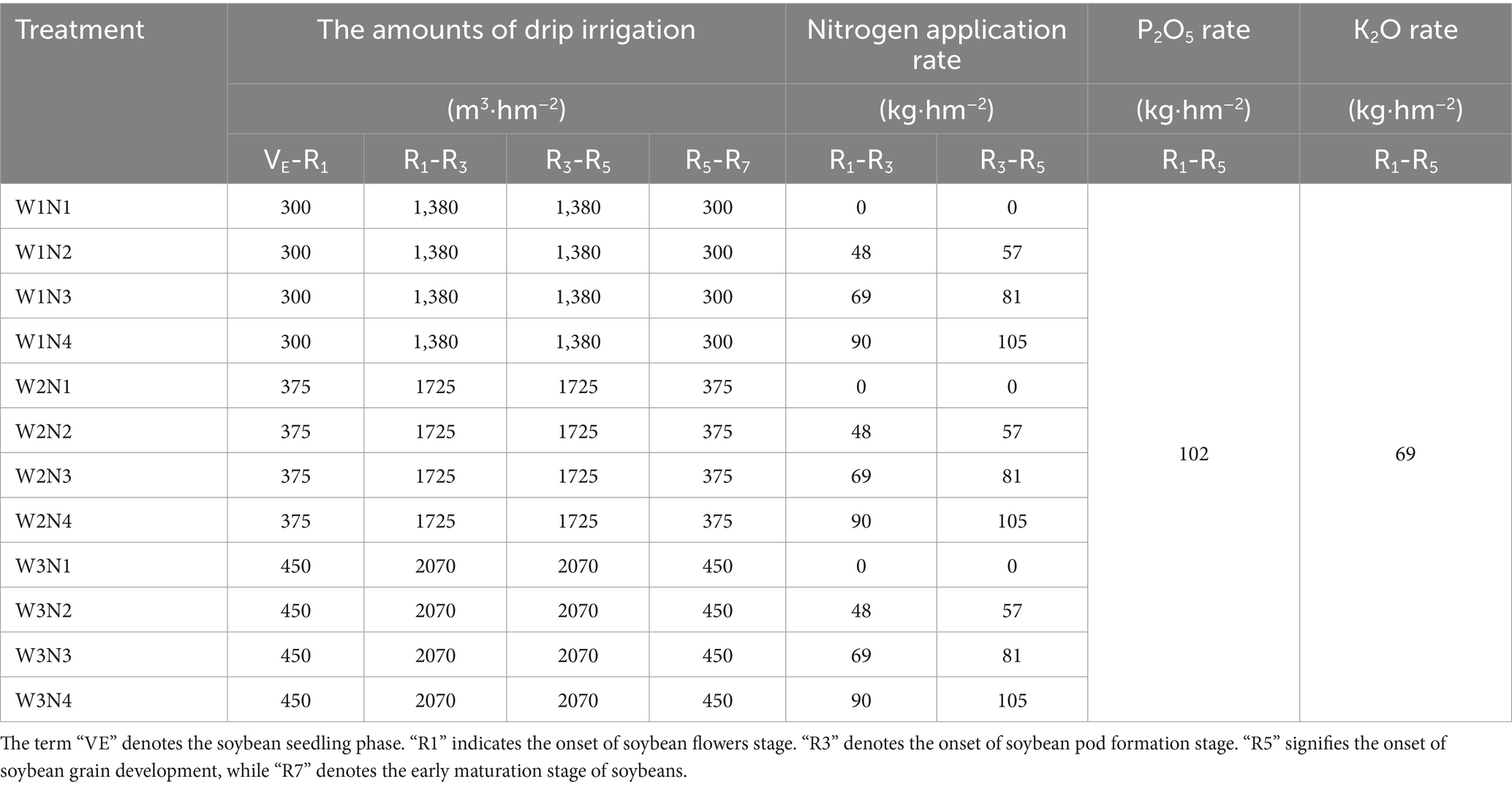
Table 2. Application of water and nitrogen application at full growth stage of relay-cropped soybean.
2.2 Sampling and measurement
2.2.1 Agronomic trait
Five plants were randomly selected at the R6 (full seed stage) for measurement of soybean plant height. This was done using a scale with 1 mm accuracy. The leaf area of individual soybean plants was quantified using a LI-3100C (LI-COR: Lincoln, Nebraska, United States) digital leaf area meter, and subsequently converted to leaf area index (LAI).
2.2.2 Photosynthesis indicators
The inverted trifoliate leaves of soybean were measured at R6 (full seed stage) of growth and development. The measurements were taken using a portable SPAD-502 (Minolta Camera Co. Ltd., Osaka, Japan) chlorophyll meter and a Li-6400 (Licor Biosciences, Lincoln, NE, United States) photosynthesizer. The SPAD values were obtained along with the net photosynthetic rate (Pn), transpiration rate (Tr), stomatal conductance (Gs) of the leaf blades and the intercellular CO2 concentration (Ci). Five replicate measurements were averaged per parameter.
2.2.3 Number of flowers and pods
From R1 (the onset of soybean flowers stage), five soybean plants exhibiting uniform growth were identified and the number of flowers was quantified at two-day intervals until the conclusion of the flowering stage. From R3 (the onset of soybean pod formation stage), three plants with uniform growth were selected and labeled. The number of pods was counted from the time that they reached 2 cm, and a count was made at intervals of 5 days until the number of pods remained constant.
2.2.4 Determination of dry matter mass accumulation
At the R6 (full seed stage), five representative plants were selected and subsequently divided into four distinct sections: leaves, stalks, pods and seeds. Each plant part was then subjected to a series of treatments. The fresh and dry weights were determined, and the quantity of dry matter in the various parts was calculated.
2.2.5 Measure yield components
Ten plants were randomly selected from each plot to determine yield components, following variables were recorded: plant height, number of fertile pods per plant, number of grains per plant, and 100-grain weight of soybeans. The mean values of these indexes were then calculated.
2.3 Statistical analysis
The data was processed using Microsoft Excel 2016 software, and graphs were plotted using Origin 2022 software. Statistical analyses were conducted using SPSS 27.0, and one-way ANOVA and Duncan’s method were employed for analysis of variance and multiple comparisons.
3 Results
3.1 Changes in agronomic traits
Under W1 and W2 irrigation, soybean plant height increased quadratically with nitrogen application over 2 years, peaking at N3 before declining (Figure 2). In 2023, plant height under W1N3 exceeded W1N2 and W1N4 by 27.85 and 35.20%, respectively, whereas W2N3 showed 8.15 and 4.17% greater height than W2N2 and W2N4. Similarly in 2024, W1N3 showed 17.98 and 16.19% greater height than W1N2 and W1N4, with W2N3 surpassing W2N2 and W2N4 by 12.53 and 7.07%. At W3 irrigation, W3N4 produced the tallest plants (61.85 cm in 2023; 57.87 cm in 2024), significantly exceeding other treatments.
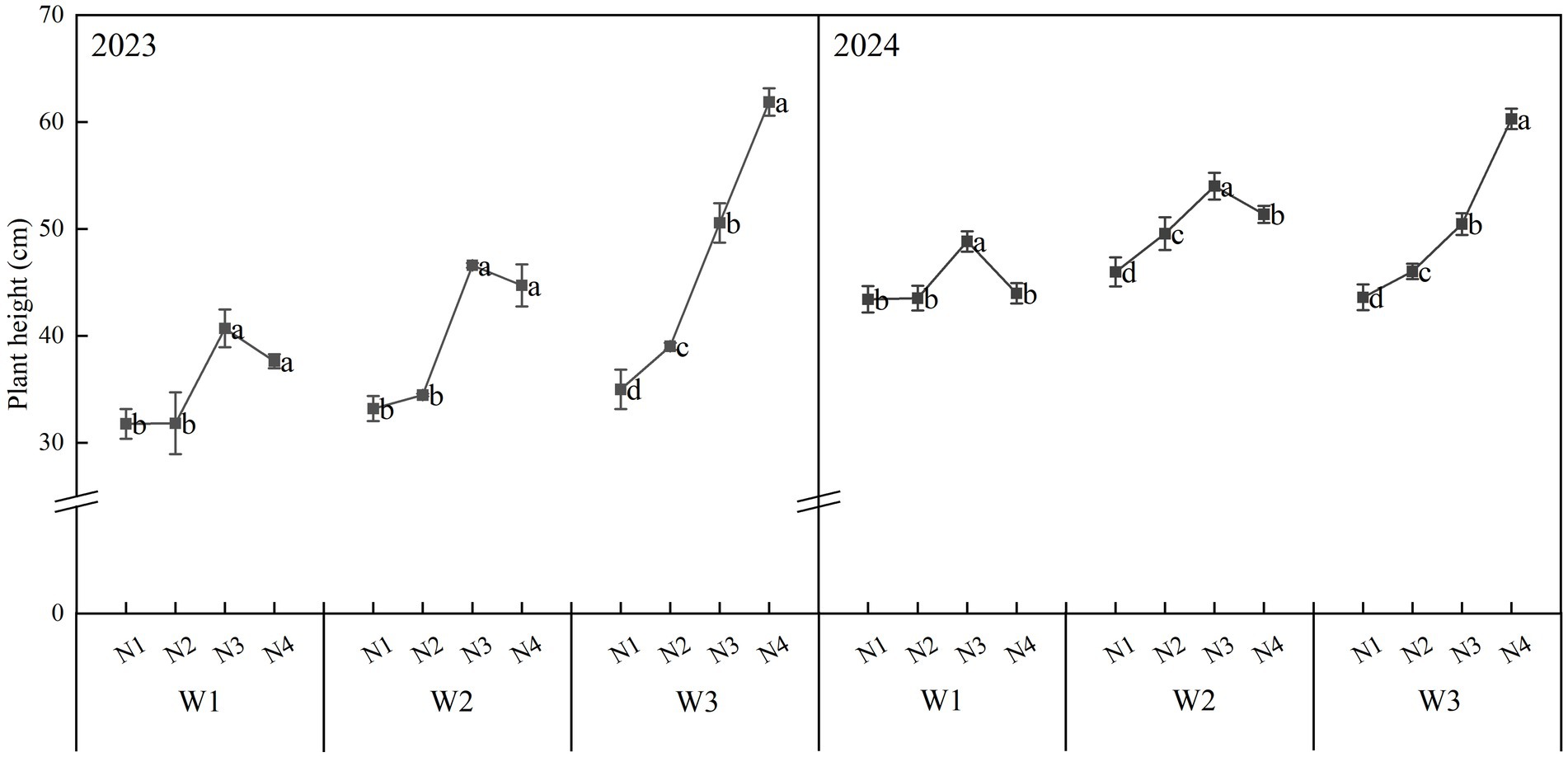
Figure 2. Plant height of relay-cropped soybean under different water and nitrogen treatments. Different letters denote significant differences (p < 0.05) within the same year.
Over both years, LAI exhibited a unimodal response to nitrogen under each irrigation level, peaking at N3 (Figure 3). In 2023, LAI showed a quadratic response to irrigation, reaching a maximum of 2.60 under W2N3. In 2024, LAI increased significantly with irrigation, attaining 2.24 under W3N3.
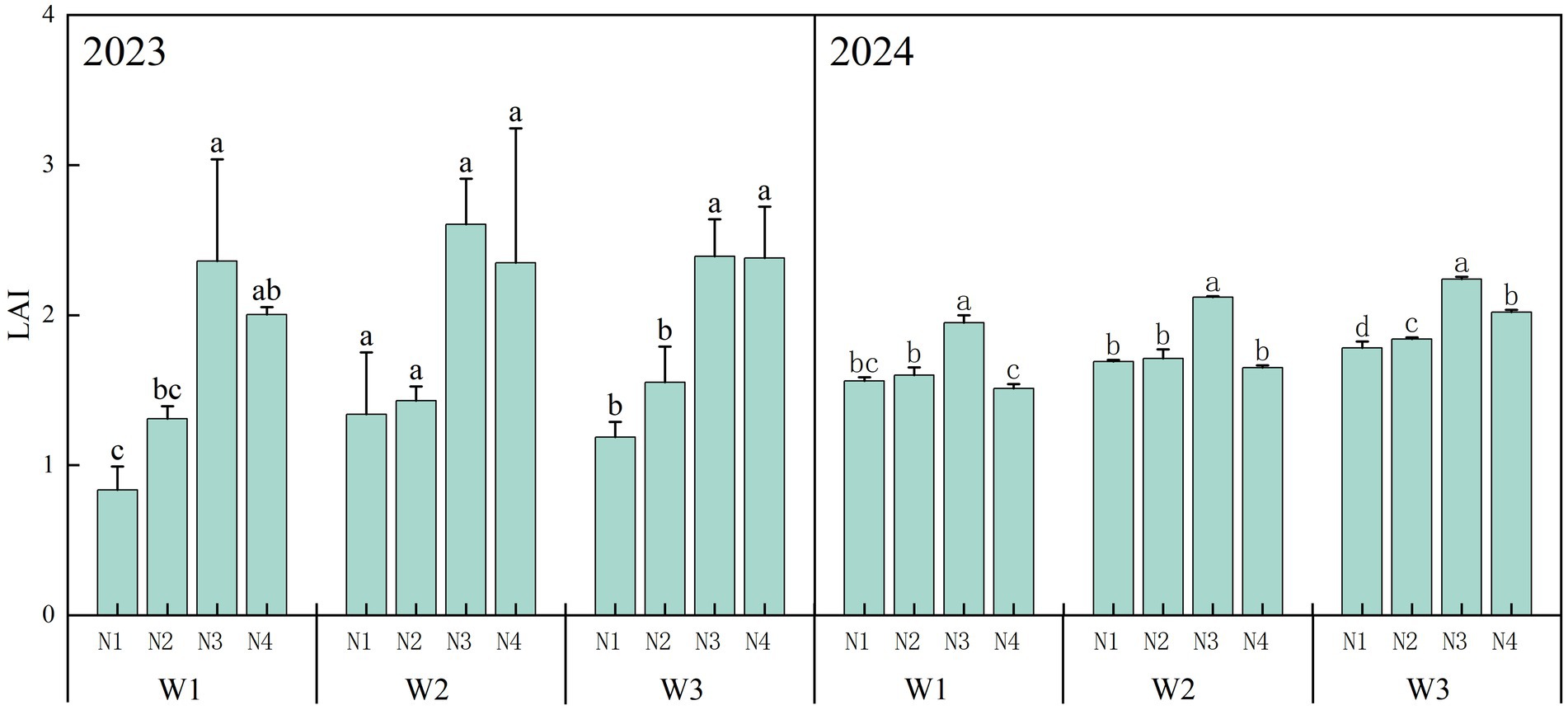
Figure 3. Leaf area index (LAI) of soybean under different water and nitrogen treatments. Different letters denote significant differences (p < 0.05) within the same year.
3.2 Changes in dry matter accumulation and distribution
Above-ground biomass (AGB) of relay-cropped soybean increased with irrigation under all fertility conditions (Figure 4). In both years, AGB exhibited a quadratic response to nitrogen application, peaking at N3, except under W3 irrigation in 2023. At the W3 irrigation level in 2023, AGB increased linearly with nitrogen application, peaking at N4 (W3N4 treatment).
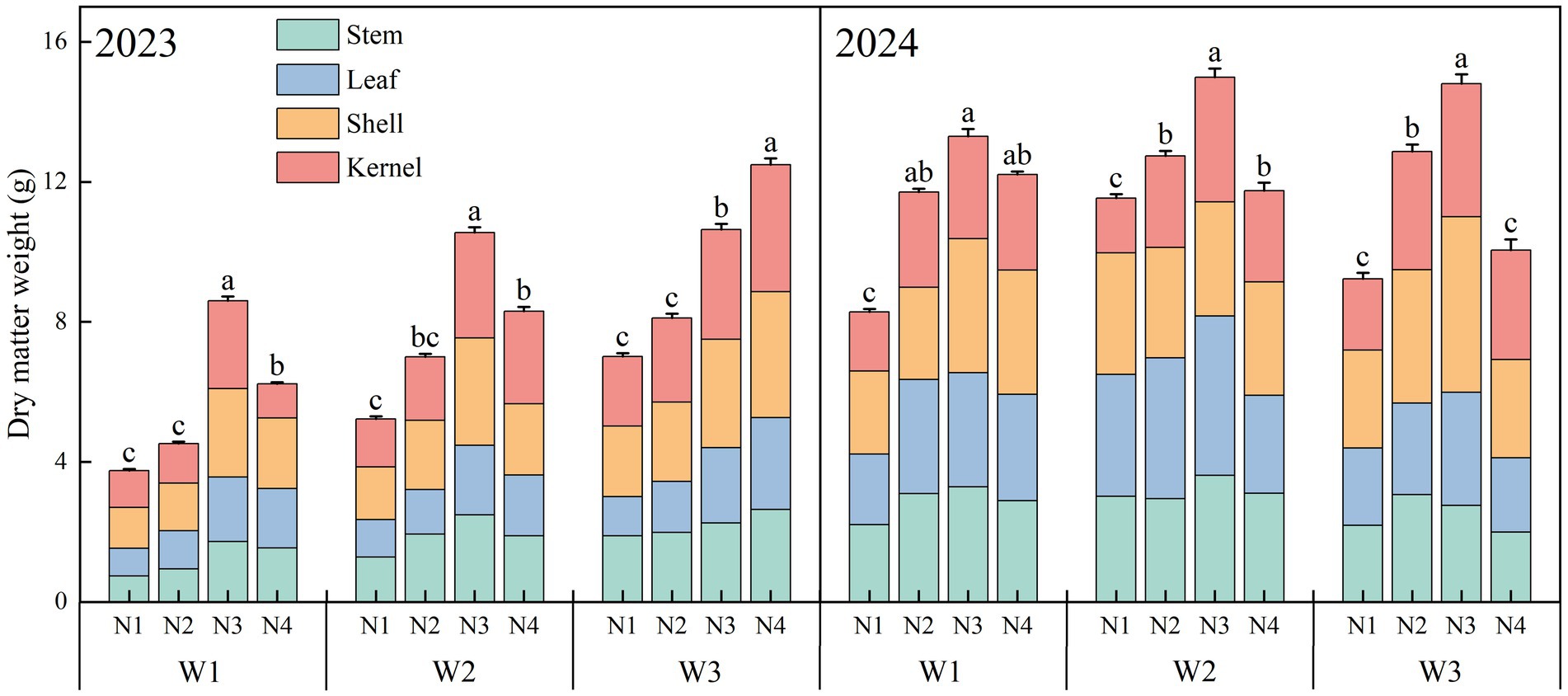
Figure 4. Dry matter weight and distribution proportion in the above-ground part of single soybean plants under different water and nitrogen treatments. Different letters denote significant differences (p < 0.05) for total dry matter within the same year.
During late-season growth, vegetative biomass accumulation (stems + leaves) decelerates as nutrients are substantially remobilized from vegetative to reproductive organs, driving rapid pod biomass growth. Total dry matter accumulation was significantly higher for W1N3, W2N3, and W3N4 than for the other treatments.
3.3 Changes in photosynthetic characteristics
Chlorophyll SPAD values under different treatments are presented in Table 3. In 2023, SPAD values peaked under W2 (W3 > W1). In 2024, SPAD values increased significantly with irrigation (W3 > W2 > W1). Across both years, SPAD values showed a quadratic response to nitrogen (initial increase followed by decrease), with values ranked N3 > N4 > N2 > N1. ANOVA indicated significant main effects of irrigation, nitrogen, year, and their three-way interaction on SPAD values (p < 0.05), but no significant irrigation × nitrogen interaction.
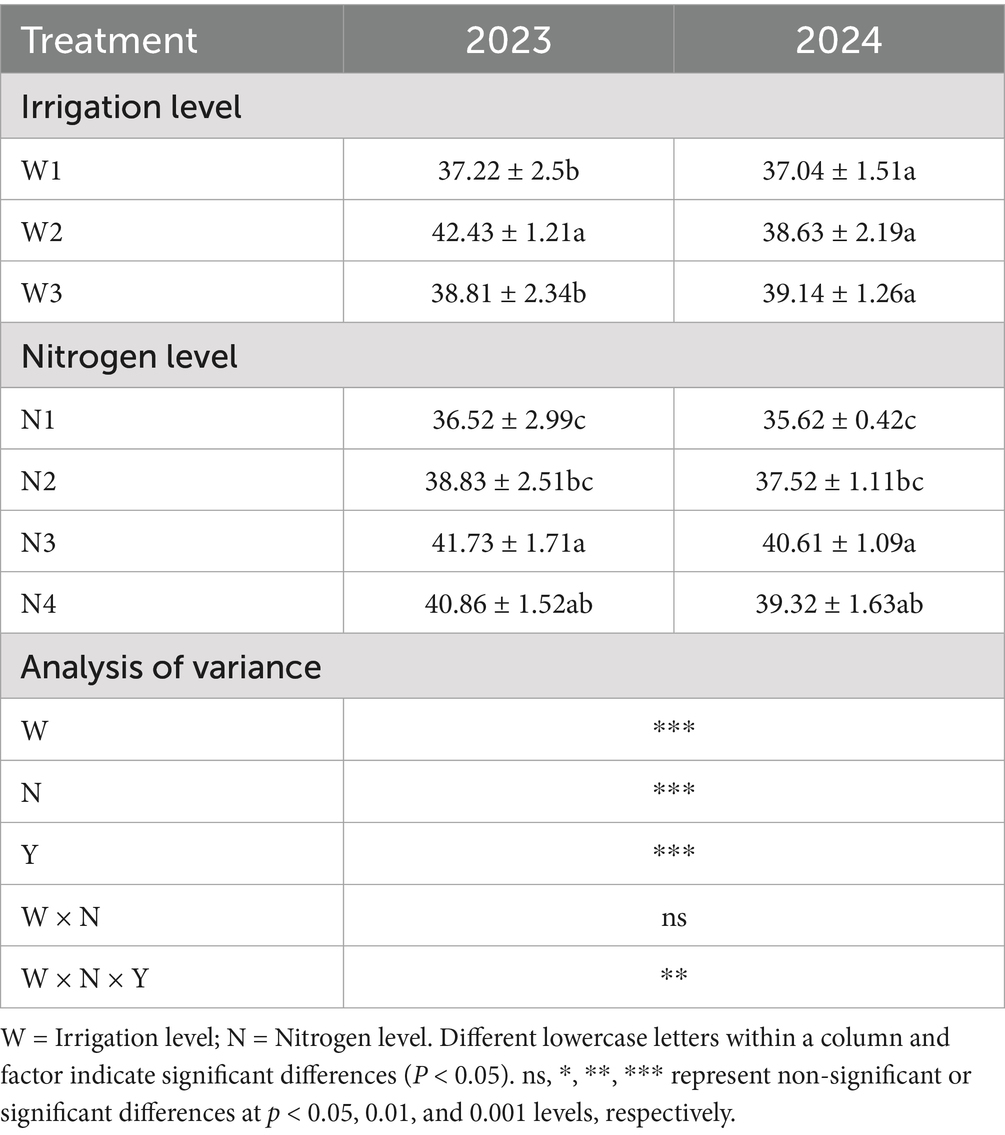
Table 3. Effects of different water and nitrogen combinations on chlorophyll SPAD value of relay-cropped soybean.
Figure 5 shows photosynthetic parameter changes in soybean leaves after 2 years of differential treatments. The net photosynthetic rate (Pn) consistently showed a quadratic response to nitrogen application across both years: increasing then decreasing. Values peaked under N3 (N3 > N4 > N2 > N1), reaching maxima at W2N3 (30.3 μmol·m−2·s−1 in 2023; 25.58 μmol·m−2·s−1 in 2024).
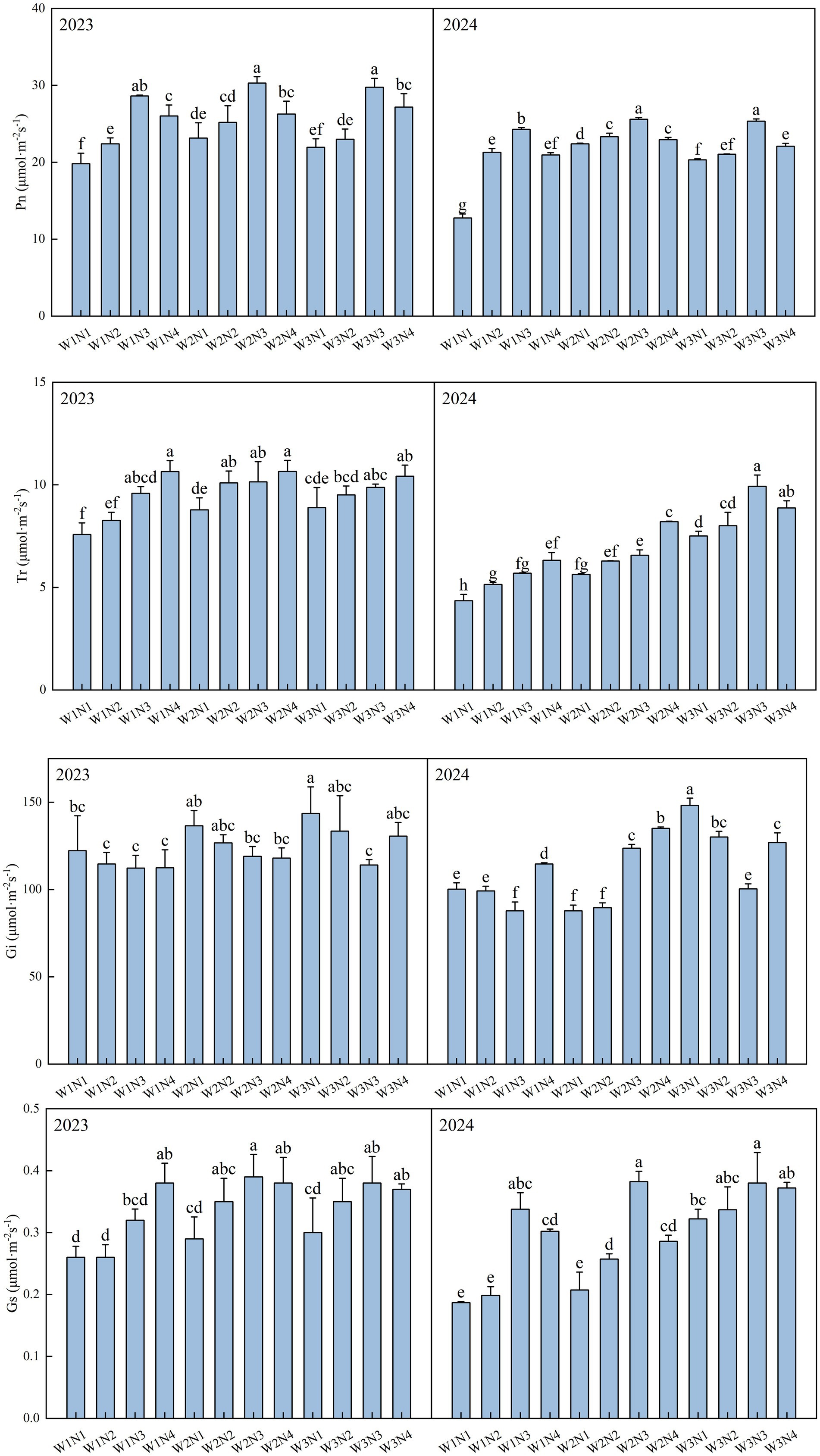
Figure 5. Photosynthetic parameters of relay-cropped soybean leaves: net photosynthetic rate (Pn), transpiration rate (Tr), intercellular CO₂ concentration (Ci), and stomatal conductance (Gs). Different letters denote significant differences (p < 0.05) within the same year and irrigation level.
The transpiration rate (Tr) generally increased with nitrogen application across irrigation levels, peaking at N4. However, under W3 irrigation in 2024, Tr showed a parabolic response to nitrogen, peaking at N3 (8.88 μmol·m−2·s−1). In 2023, W2N4 recorded the highest Tr (10.66 μmol·m−2·s−1).
Stomatal conductance (Gs) typically exhibited a parabolic response to nitrogen application across years, peaking at N3. Exceptions occurred under W1 and W2 irrigation in 2023, where Gs increased linearly with nitrogen and peaked at N4.
Intercellular CO₂ concentration (Ci) generally showed inverse patterns to Gs. Trends varied by treatment: W3 (2023) & W1/W3 (2024): Ci showed a U-shaped trend during growth progression. W1/W2 (2023): Ci decreased with nitrogen application. W2 (2024): Ci increased with nitrogen application.
3.4 Changes in flowering and pod formation characteristics
Under consistent nitrogen application, both effective flower and pod numbers per plant exhibited a quadratic response to increasing irrigation over 2 years (initial increase followed by decrease; Table 4). Optimal values occurred at W2 irrigation, with W2 and W3 showing no significant difference. Under constant irrigation, pod numbers peaked at N3.
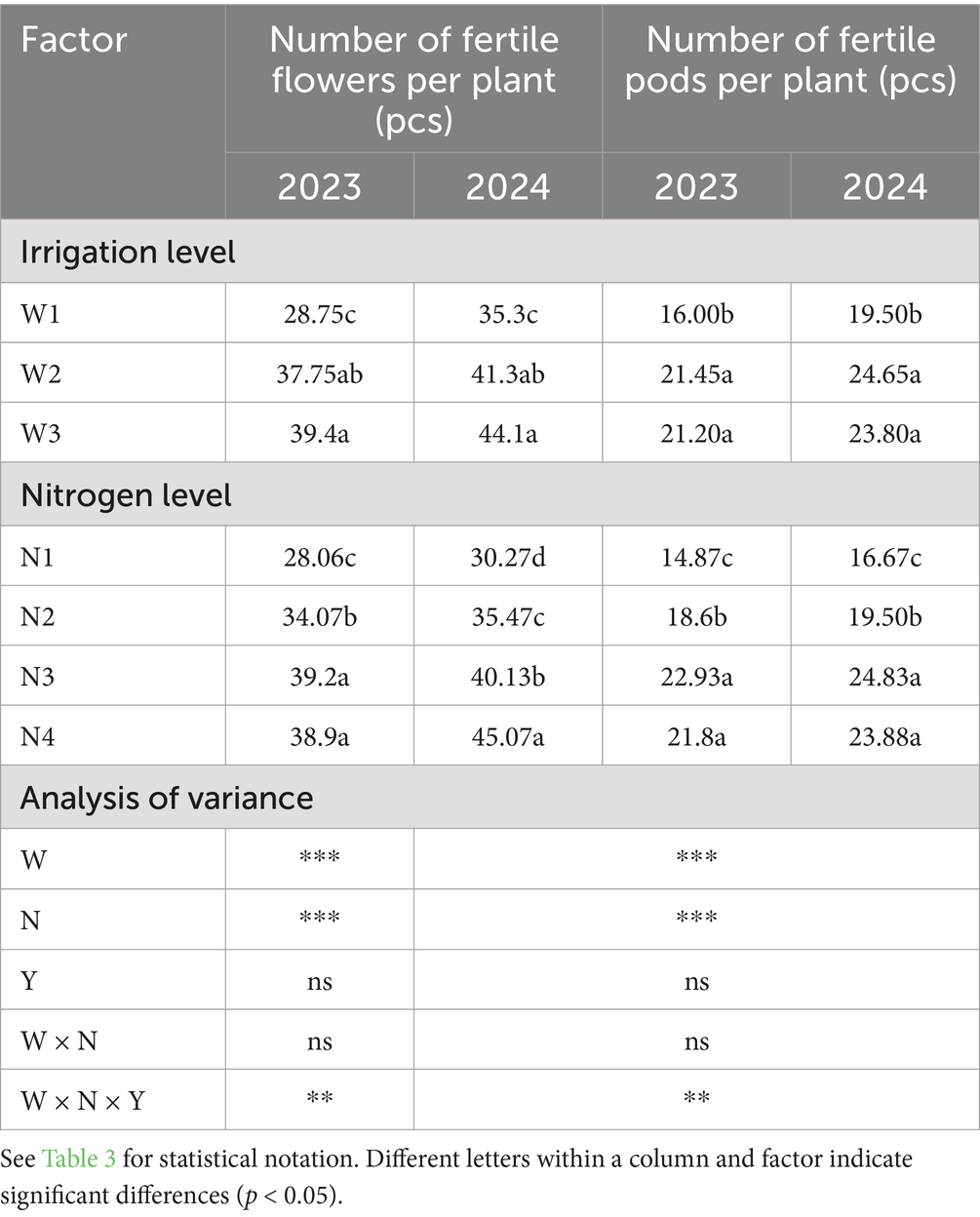
Table 4. Effects of different water and nitrogen combinations on flowering and its components of relay-cropped soybean.
For flower numbers in 2023, N3 increased values by 15.06% versus N1 and 0.77% versus N4. In 2024, N3 produced 32.57% more flowers than N1, 13.14% more than N2, but 10.96% fewer than N4.
ANOVA indicated significant main effects of irrigation, nitrogen, and their interactions with year (p < 0.05) on reproductive parameters, but no significant irrigation × nitrogen interaction.
Flower and pod abortion patterns remained consistent across both years (Figure 6). The abortion rate showed a U-shaped response to irrigation: highest under W1, followed by W3 and W2. With increasing nitrogen application, abortion rates reached a minimum at N3, then increased in the order N1 < N2 < N4.
Total flowers and pods showed positive correlations with irrigation levels in both years (Figure 7). At W1 and W3 irrigation, flower numbers increased with nitrogen application. Under W2 irrigation, flowers exhibited a quadratic response to nitrogen, peaking at N3.
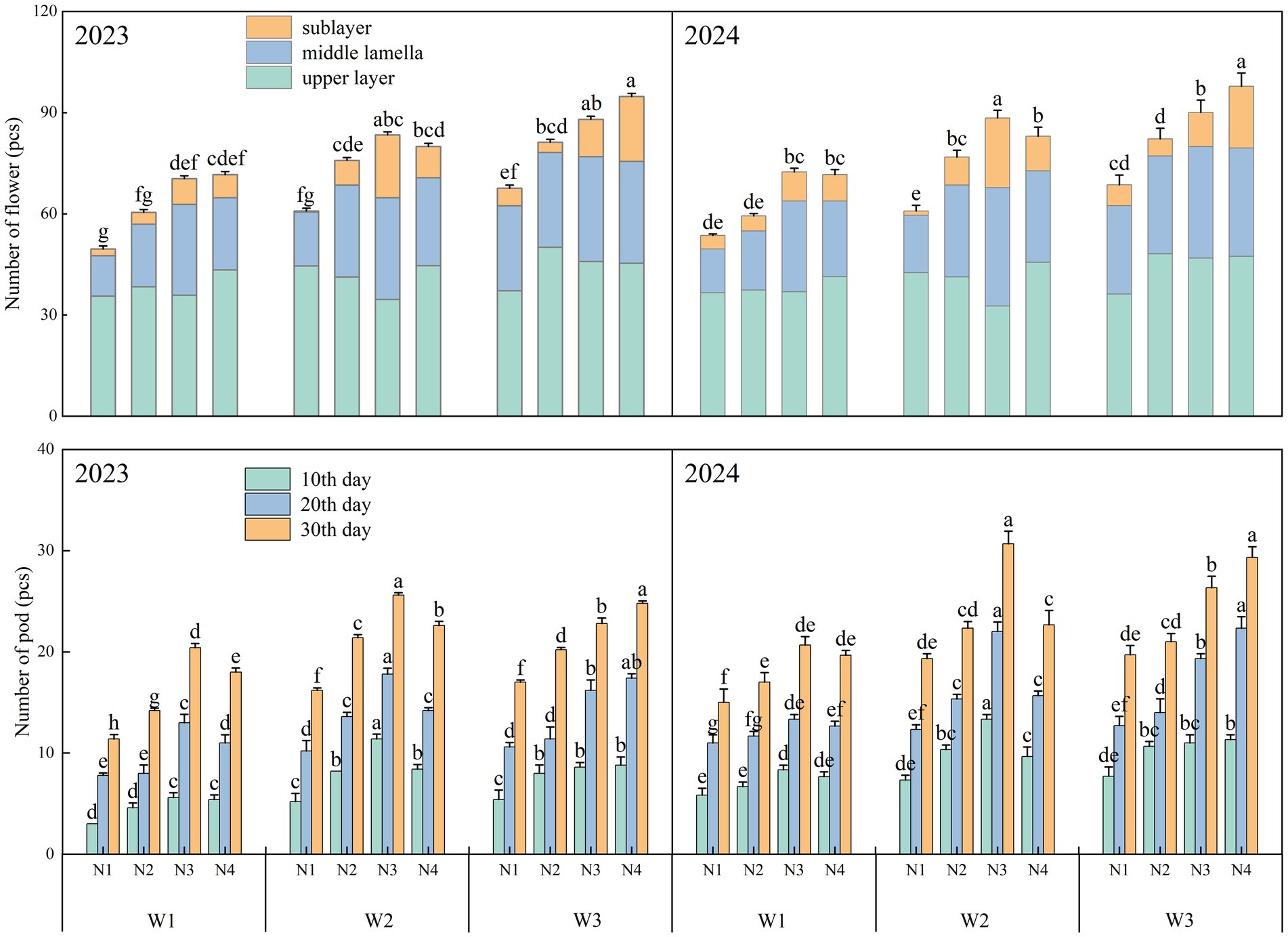
Figure 7. Soybean flower number and pod number dynamics under different water and nitrogen treatments. Different letters denote significant differences (p < 0.05) for total flowers/pods within the same year and canopy position.
Upper-canopy flowers consistently outnumbered lower-canopy flowers. In both years under W2N3: 2023: Flower numbers exceeded W2N1, W2N2, and W2N4 by 37.17, 10.03, and 4.25%, respectively. 2024: Values surpassed W2N1, W2N2, and W2N4 by 45.41, 15.10, and 6.52%.
Pod numbers under W1/W2 irrigation showed quadratic responses to nitrogen (N3 > N4 > N2 > N1), while W3 showed linear increases. W2 level showed both the greatest temporal variation in pod development and the highest fertile pod numbers (W2N3: 25.67 pods/plant in 2023; 30.67 in 2024).
3.5 Changes in the composition of yield and water-nitrogen use efficiency
Soybean yield components are presented in Table 5. At W1 and W2 irrigation, pod number per plant under N3 surpassed N1 and N2 by 38.2–52.6% (p < 0.01) and N4 by 6.3–11.7% (p < 0.05). N4 consistently reduced these components relative to N3. Under conventional irrigation (W3), values peaked at N4.
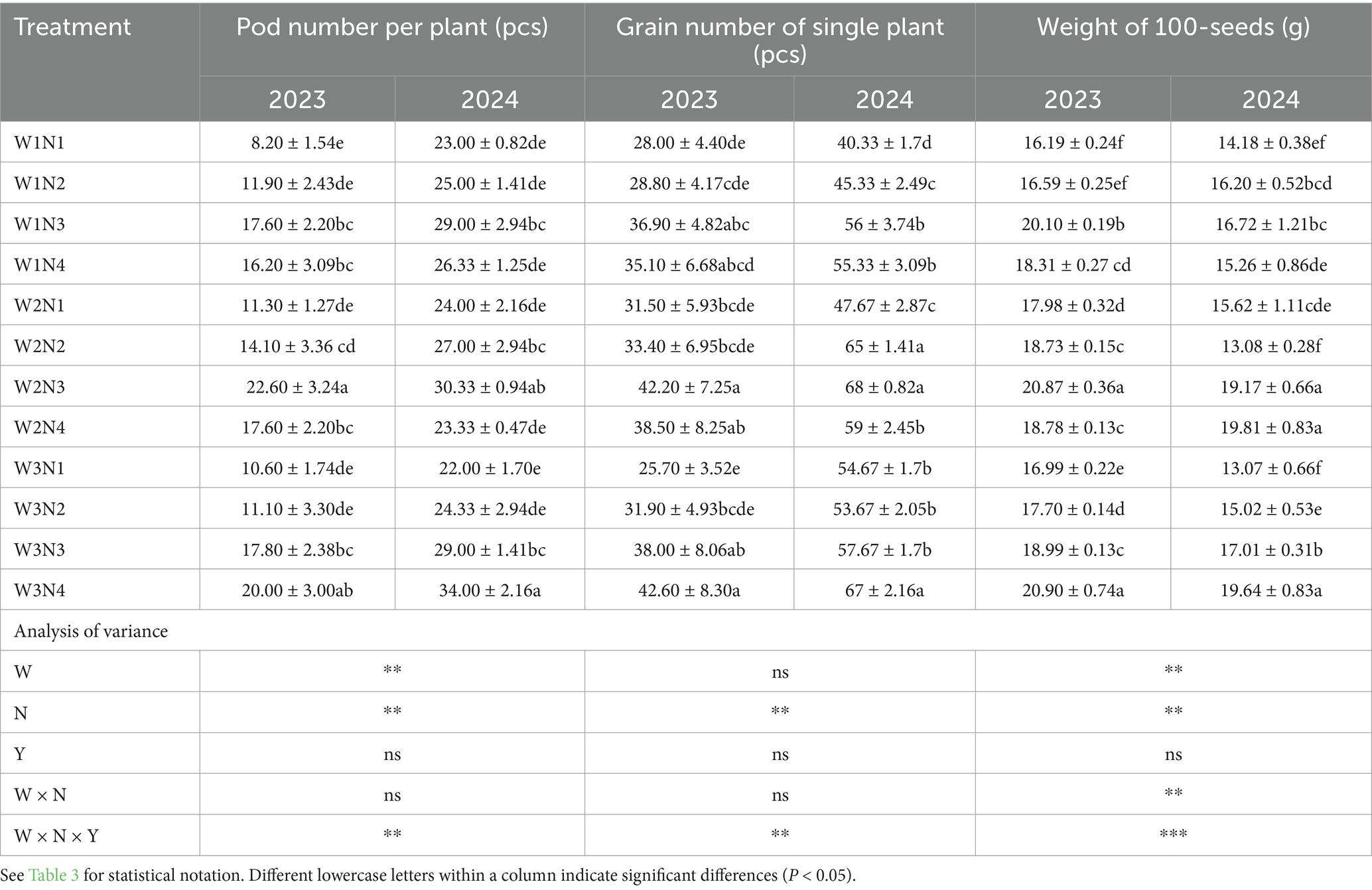
Table 5. Effects of different water and nitrogen combinations on yield-related traits of relay-cropped soybean.
Analysis revealed: Significant main effects of nitrogen on all yield components (p < 0.05). Significant main effects of irrigation on all components except grain number per plant (p < 0.05). Significant water × nitrogen interactions for 100-grain weight and grain yield (p < 0.05).
Soybean yield responses are shown in Table 6. Under W1 and W2 irrigation, grain yield showed a quadratic response to nitrogen, peaking at N3 (significantly different from other N levels: p < 0.05). N4 reduced yields relative to N3. At W3 irrigation, yields peaked at N4.
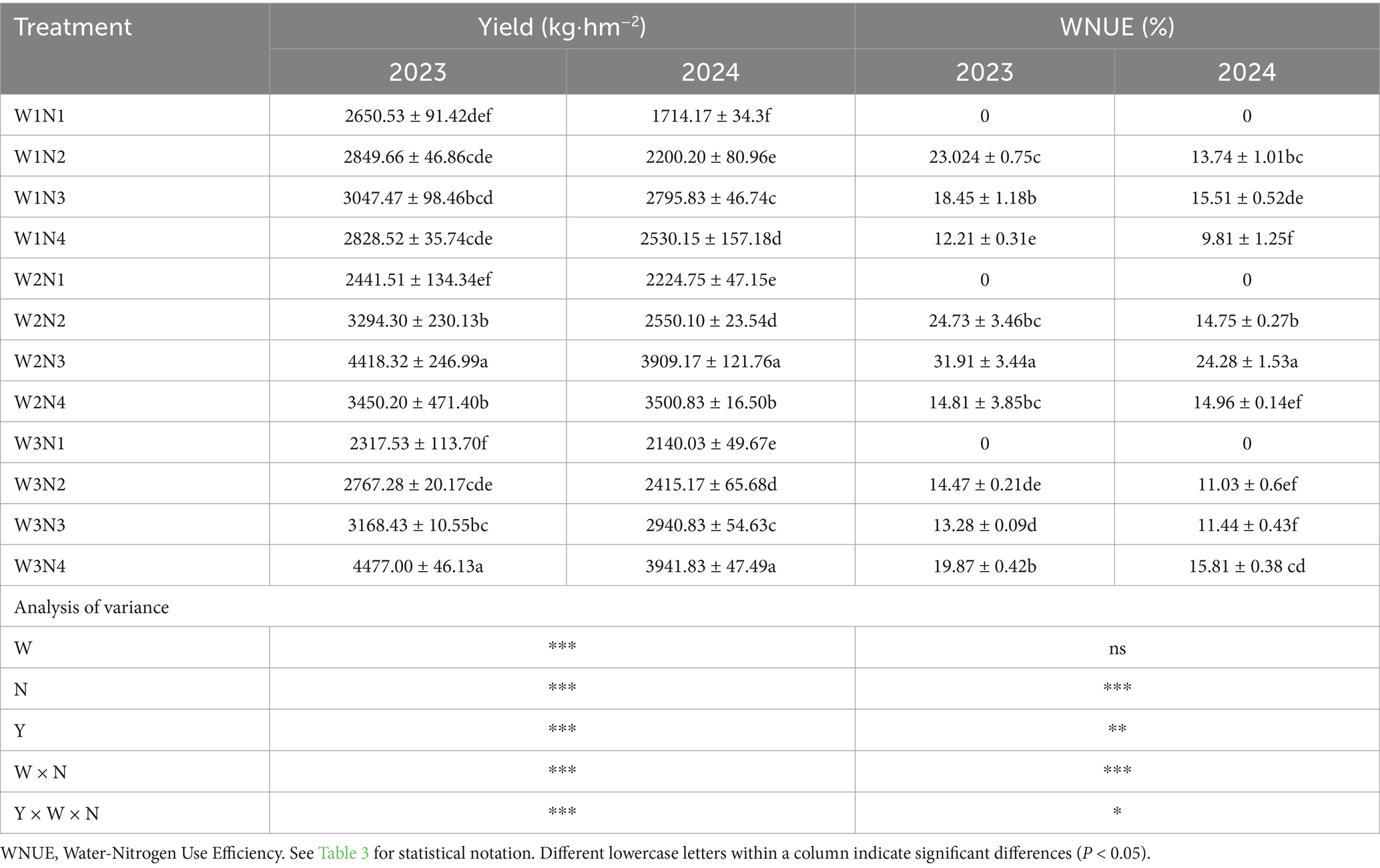
Table 6. Effects of soybean crop yield and water-nitrogen use efficiency on the efficacy of different treatments in varying years.
Optimal yields occurred at: W1N3: 3047.47 kg·ha−1 (2023); 2795.83 kg·ha−1 (2024). W2N3: 4418.82 kg·ha−1 (2023); 3909.17 kg·ha−1 (2024). W3N4: 4477.00 kg·ha−1 (2023); 3941.83 kg·ha−1 (2024).
No significant yield difference existed between W2N3 and W3N4 (p > 0.05). ANOVA indicated significant main effects of nitrogen, irrigation, year, and their interactions on yield (p < 0.05).
4 Discussion
4.1 Effect of water conservation and nitrogen application on growth and development
Growth metrics directly reflected the physiological responses of relay-cropped soybean to water and nitrogen inputs. Appropriate management enhances crop growth, while excess application inhibits development (Zhang et al., 2022). Studies confirm that moderate water and nitrogen increases promote soybean growth, elevating above-ground biomass and leaf area index (Liao et al., 2022). However, excessive nitrogen prolongs vegetative growth, delays maturity, increases plant height, and suppresses reproductive structure development while raising lodging risk (Gebre and Earl, 2021; Lawlor et al., 2001). Our results align with predecessor (Chi et al., 2023): Moderate nitrogen reduction maintains soybean plant architecture while extending dry matter allocation to pods, thereby enhancing yield. Reproductive-stage nitrogen timing critically influences growth dynamics. Specifically, plant height, leaf area index, and above-ground biomass exhibited quadratic responses to nitrogen under W1/W2 irrigation, peaking at N3. Conversely, under W3 irrigation, plant height peaked at N4, exceeding N3-level performance.
N3 optimized dry matter accumulation (Figure 4), likely due to enhanced nitrogen partitioning to reproductive organs under moderate resource constraints (Worku et al., 2012). In contrast, W3 required higher nitrogen (N4) to achieve similar biomass, indicating luxury consumption. At W1 and W2 irrigation, N3 maximized dry matter accumulation. Coordinated reduction (W2N3) maintained vegetative and reproductive development, achieving yield parity with W3N4 while enhancing resource efficiency and grain yield potential.
4.2 Effects of water conservation and nitrogen application on photosynthetic characteristics
The leaf area index (LAI) reflects photosynthetic area size and indicates photosynthetic capacity (Adams et al., 2016; He et al., 2024). Enhanced photosynthetic parameters—including Pn, Tr, Gs, Ci, and chlorophyll content—improve photosynthetic efficiency and increase yield potential (Anten, 2005; Hu et al., 2020). Studies demonstrate that: At fixed irrigation levels, soybean photosynthetic parameters increase with nitrogen application to an optimal threshold, beyond which excess nitrogen reduces chlorophyll concentration and Pn (Gai et al., 2017b). Under optimal nitrogen, photosynthetic parameters increase with irrigation but decline with excessive water (He et al., 2017). Our findings align with this pattern: photosynthetic parameters (Pn, Tr, Gs) decreased or stabilized across treatments except W2N3, which showed significant increases. This response correlates with chlorophyll dynamics, which naturally decline during maturation (Locke and Ort, 2014). Moderate water and nitrogen reduction may: Maintain leaf integrity and delay senescence. Sustain photosynthetic activity (Shafii et al., 2011). Offset yield losses while improving water/nitrogen use efficiency (Ru et al., 2022).
Soybean under W2N3 achieved optimal photosynthetic efficiency at R6, outperforming W3N4 and other treatments. Reduced inputs (relative to high-input regimes) prolonged leaf functional lifespan, maintained higher green leaf area at R6, and sustained superior photosynthetic capacity, enhancing yield potential while conserving resources.
4.3 Effects of water conservation and nitrogen application on photosynthetic characteristics
The effective number of flower pods is a key indicator of soybean yield (Board and Kahlon, 2011). Reduced irrigation decreases floral node formation and promotes flower abscission (Atti et al., 2004). Fertilizer application combined with increased irrigation enhances pod development in soybeans (Basal and Szabo, 2020), consistent with our findings. Fertile flower counts in W1 and W2 were significantly lower than in W3 by 27.03 and 5.46%, respectively. Fertile pods decreased by 24.53% in W1 compared to W3 but increased by 1.18% in W2. This reversal resulted from excessive irrigation in W3 prolonging vegetative growth, thereby shortening the reproductive phase and increasing flower abortion. Nitrogen application significantly reduced floral abscission, explaining the enhanced pod formation under optimized W2 inputs. Furthermore, elevated nitrogen rates under reduced irrigation stimulate soybean pod formation (Kinugasa et al., 2012; Li et al., 2024). Similarly, relay-cropped soybean exhibited significantly higher fertile flower and pod counts at N3 and N4 nitrogen levels than at N1 and N2 (p < 0.05). While fertile flower numbers did not differ significantly between N3 and N4 (p > 0.05), pod counts were significantly higher (p < 0.05). This divergence may result from excessive nitrogen inhibiting pod development (Ohyama et al., 2017).
4.4 Effects of water conservation and nitrogen application on yield and yield components
Crop growth and development depend on synergistic water-nitrogen interactions. Imbalanced inputs compromise both yield and quality (Du et al., 2017), making optimal water-nitrogen ratios essential. Appropriate irrigation enhances nitrogen-use efficiency (NUE), while balanced nitrogen application maximizes water-use efficiency (WUE) (Liu et al., 2020; Ye et al., 2013). Prior research confirms that nitrogen application rates must be adjusted precisely according to irrigation levels to maximize soybean yield (Sun et al., 2012).
In this experiment, under consistent irrigation, all three yield components of relay-cropped soybean—pods per plant, grains per plant, and 100-grain weight—exhibited quadratic responses to increasing nitrogen, peaking at the N3 application rate. These findings align with previous studies showing that under water-limited conditions (W1/W2), nitrogen application increases both yield index (YI) and water-nitrogen use efficiency (WNUE). Conversely, excessive irrigation (W3) impairs nitrogen efficacy, reducing soybean yield and WNUE (Purcell and King, 1996; Ray et al., 2006; Salvagiotti et al., 2008; Tamagno et al., 2018).
Relay-cropped soybean yield was optimal under W2N3 and W3N4 treatments, reaching 4477.00 and 4418.82 kg·hm−2 in 2023, and 3909.17 and 3941.83 kg·hm−2 in 2024, respectively. The yield parity between W2N3 and W3N4 demonstrates that resource conservation need not compromise productivity (Zhou et al., 2011b). Reducing inputs conserves resources while maintaining comparable yields with higher water-nitrogen utilization efficiency.
5 Implications for soil health and sustainability
The demonstrated benefits of the W2N3 regime (16.6% water saving, 23.1% N reduction) on soybean productivity and resource use efficiency hold significant promise not only for farm economics but also for environmental sustainability, particularly concerning soil health. Reducing nitrogen fertilizer inputs (N3 vs. N4) directly lowers the risk of residual soil nitrate accumulation, thereby mitigating potential leaching to groundwater and emissions of nitrous oxide (N2O)(Min et al., 2012; Yang et al., 2017; Lu et al., 2021). Concurrent water reduction (W2 vs. W3) decreases the total salt load introduced via irrigation water—a critical consideration in Xinjiang’s arid, evaporative environment where secondary salinization is a persistent threat (Liu et al., 2012; Wang Q. et al., 2016). While drip irrigation (used in this study) offers superior control over water and salt movement compared to flood methods, careful monitoring of root zone salinity under reduced irrigation remains essential.
Furthermore, sustaining high crop biomass production, as achieved under W2N3, ensures substantial inputs of root residues and senesced plant material into the soil. Although direct soil health parameters were not measured, the high crop biomass under W2N3 (Figure 4) suggests potential for increased organic matter input, which may improve soil structure and carbon sequestration (Novelli et al., 2017; Shahbaz et al., 2017). Adequate, but not excessive, water and nitrogen availability (as in W2N3) generally supports microbial communities responsible for nutrient cycling and organic matter stabilization. In contrast, severe water stress (W1) can suppress microbial activity, while excessive N (N4) might accelerate SOC mineralization in some contexts (Bogati and Walczak, 2022; Li G. et al., 2021; Murphy et al., 2017).
We acknowledge that this study focused on plant responses and did not directly measure changes in soil physicochemical properties (e.g., SOC, salinity, mineral N residues), microbial biomass, or community structure. Therefore, the discussed soil health implications are inferred from treatment effects on plant growth and established soil science principles. To conclusively evaluate the long-term sustainability and environmental footprint of the W2N3 water-nitrogen management strategy, future research must incorporate comprehensive monitoring of key soil health indicators, including SOC dynamics, nutrient balances (especially nitrogen), salinity levels, and microbial functional diversity, over multiple cropping cycles.
5.1 Economic feasibility and farmer adoption potential
W2N3 demonstrates compelling economic viability for Xinjiang farmers. Direct cost reductions of 483.91 CNY·hm−2 —primarily from water (210.00 CNY·hm−2) and nitrogen fertilizer (273.91 CNY·hm−2) savings—outweighed minor yield-related revenue losses (75.12–133.81 CNY·hm−2), generating a net profit gain of 350.10–408.79 CNY·hm−2 (urea: 2,800 CNY·t−1; water: 0.25 CNY·m−3). These water savings can be achieved using existing drip irrigation infrastructure, widely used in Xinjiang (Li et al., 2022; Lin et al., 2024; Wang et al., 2018). Scaled to Shihezi City’s 13,400 hectares of wheat fields suitable for soybean relay-cropping, W2N3 could reduce regional water withdrawals by 11,300 m3 annually while maintaining near-equivalent soybean production.
6 Conclusion
This two-year study demonstrates that reducing irrigation by 16.6% (4,200 m3·hm−2) and nitrogen by 23.1% (150 kg·hm−2) in post-wheat relay-cropped soybean (W2N3 regimen) enhances photosynthetic efficiency and pod formation while maintaining yield (≤1.32% reduction vs. conventional W3N4). It boosts economic viability through reduced water and fertilizer costs (net profit increase: 350.10–408.79 CNY·hm−2) and demonstrates scalability in Xinjiang’s drip-irrigated systems. W2N3 is recommended as an optimal strategy for balancing yield, resource conservation, and economic returns in arid regions.
Data availability statement
The original contributions presented in the study are included in the article/Supplementary material, further inquiries can be directed to the corresponding author.
Author contributions
HH: Investigation, Conceptualization, Data curation, Project administration, Software, Writing – review & editing, Formal Analysis, Methodology, Supervision, Writing – original draft. RG: Software, Data curation, Writing – original draft, Methodology, Conceptualization, Investigation. KD: Investigation, Writing – review & editing, Conceptualization, Project administration, Methodology. SP: Project administration, Writing – review & editing, Investigation. JL: Project administration, Writing – original draft, Data curation, Supervision, Conceptualization, Funding acquisition, Writing – review & editing.
Funding
The author(s) declare that financial support was received for the research and/or publication of this article. This research was funded by the Science and Technology Plan Project of Xinjiang Production and Construction Corps (No. 2025DA028) and the Science and Technology Innovation Special Project of Shihezi University (No. QS2023013).
Conflict of interest
The authors declare that the research was conducted in the absence of any commercial or financial relationships that could be construed as a potential conflict of interest.
Generative AI statement
The authors declare that no Gen AI was used in the creation of this manuscript.
Publisher’s note
All claims expressed in this article are solely those of the authors and do not necessarily represent those of their affiliated organizations, or those of the publisher, the editors and the reviewers. Any product that may be evaluated in this article, or claim that may be made by its manufacturer, is not guaranteed or endorsed by the publisher.
Supplementary material
The Supplementary material for this article can be found online at: https://www.frontiersin.org/articles/10.3389/fsufs.2025.1614074/full#supplementary-material
References
Adams, M. A., Turnbull, T. L., Sprent, J. I., and Buchmann, N. (2016). Legumes are different: leaf nitrogen, photosynthesis, and water use efficiency. Proc. Natl. Acad. Sci. 113, 4098–4103. doi: 10.1073/pnas.1523936113
AlShamary, W. F. A., Sharif, Y. O. N. A., Noori, N. E., and Kahlel, A. S. (2025). Effect of moisture depletion rate and irrigation water depth on the productivity and water use efficiency of soybean crop (Glycine max L.) Merr. Under drip irrigation and fixed sprinkler irrigation systems. Agric. Sci. Dig. doi: 10.18805/ag.DF-651
Anten, N. (2005). Optimal photosynthetic characteristics of individual plants in vegetation stands and implications for species coexistence. Ann. Bot. 95, 495–506. doi: 10.1093/aob/mci048
Atti, S., Bonnell, R., Smith, D., and Prasher, S. (2004). Response of an indeterminate soybean {Glycine max (L.) Merr} to chronic water deficit during reproductive development under greenhouse conditions. Can. Water Resour. J. Rev. Can. Ressour. Hydr. 29, 209–222. doi: 10.4296/cwrj209
Basal, O., and Szabo, A. (2020). The combined effect of drought stress and nitrogen fertilization on soybean. Agronomy 10. doi: 10.3390/agronomy10030384
Bellaloui, N., Bruns, H. A., Abbas, H. K., Mengistu, A., Fisher, D. K., and Reddy, K. N. (2015). Effects of row-type, row-spacing, seeding rate, soil-type, and cultivar differences on soybean seed nutrition under US Mississippi Delta conditions. PLoS One 10:e0129913. doi: 10.1371/journal.pone.0129913
Bellaloui, N., and Mengistu, A. (2008). Seed composition is influenced by irrigation regimes and cultivar differences in soybean. Irrig. Sci. 26, 261–268. doi: 10.1007/s00271-007-0091-y
Board, J. E., and Kahlon, C. S. (2011). “Soybean yield formation: what controls it and how it can be improved” in Soybean physiology and biochemistry, 1–36.
Bogati, K., and Walczak, M. (2022). The impact of drought stress on soil microbial community, enzyme activities and plants. Agronomy-Basel 12:26. doi: 10.3390/agronomy12010189
Cao, Y., Cai, H., Sun, S., Gu, X., Mu, Q., Duan, W., et al. (2022). Effects of drip irrigation methods on yield and water productivity of maize in Northwest China. Agric. Water Manag. 259. doi: 10.1016/j.agwat.2021.107227
Che, Z., Wang, J., and Li, J. (2021). Effects of water quality, irrigation amount and nitrogen applied on soil salinity and cotton production under mulched drip irrigation in arid Northwest China. Agric. Water Manag. 247. doi: 10.1016/j.agwat.2021.106738
Cheng, T., Hu, J. C., and Lin, Z. J. (2019). Effects of submergence stress on partition of dry matter and yield of rice plant. J. Henan Agric. Univ. 53, 689–693.
Chi, Y. X., Gao, F., Muhammad, I., Huang, J. H., and Zhou, X. B. (2023). Effect of water conditions and nitrogen application on maize growth, carbon accumulation and metabolism of maize plant in subtropical regions. Arch. Agron. Soil Sci. 69, 693–707. doi: 10.1080/03650340.2022.2026931
Desclaux, D., and Roumet, P. (1996). Impact of drought stress on the phenology of two soybean (Glycine max L Merr) cultivars. Field Crop Res. 46, 61–70. doi: 10.1016/0378-4290(95)00086-0
Du, Y. D., Cao, H. X., Liu, S. Q., Gu, X. B., and Cao, Y. X. (2017). Response of yield, quality, water and nitrogen use efficiency of tomato to different levels of water and nitrogen under drip irrigation in northwestern China. J. Integr. Agric. 16, 1153–1161. doi: 10.1016/S2095-3119(16)61371-0
Fu, X., Zhang, Y., Du, X., She, R., An, C., Fang, Y., et al. (2020). Effect of annual nitrogen application rate on nitrogen use efficiency and yield of summer soybean in winter wheat-summer soybean rotation system. J. Plant Nutr. Fertil. 26, 453–460.
Gai, Z., Zhang, J., and Li, C. (2017). Effects of starter nitrogen fertilizer on soybean root activity, leaf photosynthesis and grain yield. PLoS One 12:e174841. doi: 10.1371/journal.pone.0174841
Gebre, M. G., and Earl, H. J. (2021). Soil water deficit and fertilizer placement effects on root biomass distribution, soil water extraction, water use, yield, and yield components of soybean [Glycine max (L.) Merr.] grown in 1-m rooting columns. Front. Plant Sci. 12:581127. doi: 10.3389/fpls.2021.581127
Gonzalez-Dugo, V., Durand, J., and Gastal, F. (2010). Water deficit and nitrogen nutrition of crops. A review. Agron. Sustain. Dev. 30, 529–544. doi: 10.1051/agro/2009059
Hammad, H. M., Ahmad, A., Abbas, F., and Farhad, W. (2012). Optimizing water and nitrogen use for maize production under semiarid conditions. Turk. J. Agric. For. 36, 519–532. doi: 10.3906/tar-1111-24
Hammad, H. M., Ahmad, A., Abbas, F., Farhad, W., Cordoba, B. C., and Hoogenboom, G. (2015). Water and nitrogen productivity of maize under semiarid environments. Crop Sci. 55, 877–888. doi: 10.2135/cropsci2013.05.0291
He, J., Du, Y., Wang, T., Turner, N. C., Yang, R., Jin, Y., et al. (2017). Conserved water use improves the yield performance of soybean (Glycine max (L.) Merr.) under drought. Agric. Water Manag. 179, 236–245. doi: 10.1016/j.agwat.2016.07.008
He, H., Lou, X., and Liu, J. (2024). Nitrogen reduction and organic fertiliser application benefits growth, yield, and economic return of cotton. Agriculture 14. doi: 10.3390/agriculture14071073
Hoffmann, B., Varga, B., Nagy, E., Hoffmann, S., Darko, E., Tajti, J., et al. (2021). Effects of nitrogen and water deficiency on agronomic properties, root characteristics and expression of related genes in soybean. Agronomy 11. doi: 10.3390/agronomy11071329
Hou, L., Lin, R. X., Wang, X. J., Li, H., Zhao, C. Z., Zhu, X. J., et al. (2022). The mechanisms of pod zone nitrogen application on peanut pod yield. Russ. J. Plant Physiol. 69. doi: 10.1134/S1021443722030050
Hu, W., Lu, Z., Meng, F., Li, X., Cong, R., Ren, T., et al. (2020). The reduction in leaf area precedes that in photosynthesis under potassium deficiency: the importance of leaf anatomy. New Phytol. 227, 1749–1763. doi: 10.1111/nph.16644
Jha, P. K., Kumar, S. N., and Ines, A. V. M. (2018). Responses of soybean to water stress and supplemental irrigation in upper indo-Gangetic plain: field experiment and modeling approach. Field Crop Res. 219, 76–86. doi: 10.1016/j.fcr.2018.01.029
Kinugasa, T., Sato, T., Oikawa, S., and Hirose, T. (2012). Demand and supply of N in seed production of soybean (Glycine max) at different N fertilization levels after flowering. J. Plant Res. 125, 275–281. doi: 10.1007/s10265-011-0439-5
Kong, L., Xie, Y., Hu, L., Si, J., and Wang, Z. (2017). Excessive nitrogen application dampens antioxidant capacity and grain filling in wheat as revealed by metabolic and physiological analyses. Sci. Rep. 7. doi: 10.1038/srep43363
Lawlor, D. W., Lemaire, G., and Gastal, F. (2001). Nitrogen, plant growth and crop yield. Plant Nitrog, 343–367.
Li, S., Liu, X., Sun, Y., Ma, C., Gu, X., and Zhang, Q. (2022). Yield, nutrient quality and water and phosphorus recovery efficiencies of alfalfa under different drip irrigation and phosphorus levels in northern Xinjiang, China. Grass Forage Sci. 77, 189–200. doi: 10.1111/gfs.12563
Li, G., Niu, W., Sun, J., Zhang, W., Zhang, E., and Wang, J. (2021). Soil moisture and nitrogen content influence wheat yield through their effects on the root system and soil bacterial diversity under drip irrigation. Land Degrad. Dev. 32, 3062–3076. doi: 10.1002/ldr.3967
Li, S., Pu, S., Deng, F., Wang, L., Hu, H., Liao, S., et al. (2019). Influence of optimized nitrogen management on the quality of medium hybrid rice under different ecological conditions. Chin. J. Eco-Agric. 27, 1042–1052.
Li, X., Qiang, L., Qin, T., Shuai, Y., Cheng, L., and Liu, L. (2021). Effects of different detention water depths on rice growth and yield in shrimp rice fields after a heavy rain. China Rural Water Hydropower 9, 124–127, 133.
Li, M., Zhang, K., Liu, J., and Nizam Ul Din, G. (2024). Nitrogen addition mitigates drought by promoting soybean (Glycine max (Linn.) Merr) flowering and podding and affecting related enzyme activities. Agriculture 14:852. doi: 10.3390/agriculture14060852
Liao, Z., Zeng, H., Fan, J., Lai, Z., Zhang, C., Zhang, F., et al. (2022). Effects of plant density, nitrogen rate and supplemental irrigation on photosynthesis, root growth, seed yield and water - nitrogen use efficiency of soybean under ridge-furrow plastic mulching. Agric. Water Manag. 268. doi: 10.1016/j.agwat.2022.107688
Lin, S., Wang, Q., Deng, M., Su, L., Wei, K., Guo, Y., et al. (2024). Assessing the influence of water fertilizer, and climate factors on seed cotton yield under mulched drip irrigation in Xinjiang agricultural regions. Eur. J. Agron. 152:11. doi: 10.1016/j.eja.2023.127034
Liu, Q., Xu, H., Mu, X., Zhao, G., Gao, P., and Sun, W. (2020). Effects of different fertilization regimes on crop yield and soil water use efficiency of millet and soybean. Sustain. For. 12. doi: 10.3390/su12104125
Liu, M. X., Yang, J. S., Li, X. M., Yu, M., and Wang, J. (2012). Effects of irrigation water quality and drip tape arrangement on soil salinity, soil moisture distribution, and cotton yield (Gossypium hirsutum L.) under mulched drip irrigation in Xinjiang, China. J. Integr. Agric. 11, 502–511. doi: 10.1016/S2095-3119(12)60036-7
Locke, A. M., and Ort, D. R. (2014). Leaf hydraulic conductance declines in coordination with photosynthesis, transpiration and leaf water status as soybean leaves age regardless of soil moisture. J. Exp. Bot. 65, 6617–6627. doi: 10.1093/jxb/eru380
Lu, J., Hu, T., Zhang, B., Wang, L., Yang, S., Fan, J., et al. (2021). Nitrogen fertilizer management effects on soil nitrate leaching, grain yield and economic benefit of summer maize in Northwest China. Agric. Water Manag. 247:10. doi: 10.1016/j.agwat.2021.106739
Min, J., Zhang, H., and Shi, W. (2012). Optimizing nitrogen input to reduce nitrate leaching loss in greenhouse vegetable production. Agric. Water Manag. 111, 53–59. doi: 10.1016/j.agwat.2012.05.003
Murphy, C. J., Baggs, E. M., Morley, N., Wall, D. P., and Paterson, E. (2017). Nitrogen availability alters rhizosphere processes mediating soil organic matter mineralisation. Plant Soil 417, 499–510. doi: 10.1007/s11104-017-3275-0
Namvar, A., Sharifi, R. S., Sedghi, M., Zakaria, R. A., Khandan, T., and Eskandarpour, B. (2011). Study on the effects of organic and inorganic nitrogen fertilizer on yield, yield components, and nodulation state of chickpea (Cicer arietinum L.). Commun. Soil Sci. Plant Anal. 42, 1097–1109. doi: 10.1080/00103624.2011.562587
Noor, H., Wang, Q., Islam, M. A., Sun, M., Lin, W., Ren, A. X., et al. (2021). Effects of sowing methods and nitrogen rates on photosynthetic characteristics, yield, and quality of winter wheat. Photosynthetica 59, 277–285. doi: 10.32615/ps.2021.018
Novelli, L. E., Caviglia, O. P., and Pineiro, G. (2017). Increased cropping intensity improves crop residue inputs to the soil and aggregate-associated soil organic carbon stocks. Soil Tillage Res. 165, 128–136. doi: 10.1016/j.still.2016.08.008
Ohyama, T., Tewari, K., Ishikawa, S., Tanaka, K., Kamiyama, S., Ono, Y., et al. (2017). Role of nitrogen on growth and seed yield of soybean and a new fertilization technique to promote nitrogen fixation and seed yield.
Purcell, L. C., and King, C. A. (1996). Drought and nitrogen source effects on nitrogen nutrition, seed growth, and yield in soybean. J. Plant Nutr. 19, 969–993. doi: 10.1080/01904169609365173
Ran, X., Zhou, J., Mao, T., Wu, S., Wu, Q., Chen, G., et al. (2023). The effect of plant and row configuration on the growth and yield of multiple cropping of soybeans in southern Xinjiang, China. Sustain. For. 15. doi: 10.3390/su151914608
Rathore, V. S., Nathawat, N. S., Bhardwaj, S., Sasidharan, R. P., Yadav, B. M., Kumar, M., et al. (2017). Yield, water and nitrogen use efficiencies of sprinkler irrigated wheat grown under different irrigation and nitrogen levels in an arid region. Agric. Water Manag. 187, 232–245. doi: 10.1016/j.agwat.2017.03.031
Ray, J. D., Fritschi, F. B., and Heatherly, L. G. (2006). Large applications of fertilizer N at planting affects seed protein and oil concentration and yield in the early soybean production system. Field Crop Res. 99, 67–74. doi: 10.1016/j.fcr.2006.03.006
Ru, C., Hu, X., Chen, D., Song, T., Wang, W., Lv, M., et al. (2022). Nitrogen modulates the effects of short-term heat, drought and combined stresses after anthesis on photosynthesis, nitrogen metabolism, yield, and water and nitrogen use efficiency of wheat. Water 14. doi: 10.3390/w14091407
Salvagiotti, F., Cassman, K. G., Specht, J. E., Walters, D. T., Weiss, A., and Dobermann, A. (2008). Nitrogen uptake, fixation and response to fertilizer N in soybeans: a review. Field Crop Res. 108, 1–13. doi: 10.1016/j.fcr.2008.03.001
Sandoval-Villa, M., Wood, C. W., and Guertal, E. A. (2002). Tomato leaf chlorophyll meter readings as affected by variety, nitrogen form, and nighttime nutrient solution strength. J. Plant Nutr. 25, 2129–2142. doi: 10.1081/PLN-120014065
Shafii, F., Ebadi, A., Golloje, K. S., and Eshghi-Gharib, A. (2011). Soybean response to nitrogen fertilizer under water deficit conditions. Afr. J. Biotechnol. 10, 3112–3120.
Shahbaz, M., Kuzyakov, Y., Sanaullah, M., Heitkamp, F., Zelenev, V., Kumar, A., et al. (2017). Microbial decomposition of soil organic matter is mediated by quality and quantity of crop residues: mechanisms and thresholds. Biol. Fertil. Soils 53, 287–301. doi: 10.1007/s00374-016-1174-9
Si, Z., Zain, M., Mehmood, F., Wang, G., Gao, Y., and Duan, A. (2020). Effects of nitrogen application rate and irrigation regime on growth, yield, and water-nitrogen use efficiency of drip-irrigated winter wheat in the North China plain. Agric. Water Manag. 231. doi: 10.1016/j.agwat.2020.106002
Sun, Y., Ma, J., Sun, Y., Xu, H., Yang, Z., Liu, S., et al. (2012). The effects of different water and nitrogen managements on yield and nitrogen use efficiency in hybrid rice of China. Field Crop Res. 127, 85–98. doi: 10.1016/j.fcr.2011.11.015
Tamagno, S., Sadras, V. O., Haegele, J. W., Armstrong, P. R., and Ciampitti, I. A. (2018). Interplay between nitrogen fertilizer and biological nitrogen fixation in soybean: implications on seed yield and biomass allocation. Sci. Rep. 8:17502. doi: 10.1038/s41598-018-35672-1
Wan, W., Li, L., Jing, J., Diao, M., Lv, Z., Li, W., et al. (2022a). Narrowing row space improves productivity and profit of enlarged lateral space drip irrigated spring wheat system in Xinjiang, China. Field Crop Res. 280. doi: 10.1016/j.fcr.2022.108474
Wan, W., Zhao, Y., Li, X., Xu, J., Liu, K., Guan, S., et al. (2022b). A moderate reduction in irrigation and nitrogen improves water - nitrogen use efficiency, productivity, and profit under new type of drip irrigated spring wheat system. Front. Plant Sci. 13:1005945. doi: 10.3389/fpls.2022.1005945
Wang, Z., Bian, Q., Zhang, J., and Zhou, B. (2018). Optimized water and fertilizer Management of Mature Jujube in Xinjiang arid area using drip irrigation. Water 10:13. doi: 10.3390/w10101467
Wang, Q., Huo, Z., Zhang, L., Wang, J., and Zhao, Y. (2016). Impact of saline water irrigation on water use efficiency and soil salt accumulation for spring maize in arid regions of China. Agric. Water Manag. 163, 125–138. doi: 10.1016/j.agwat.2015.09.012
Wang, Y., Xu, S., Li, G., and Wang, S. (2020). Study on comparison of the advantages of different soybean producing areas in China from a temporal and spatial perspective. J. Phys. Conf. Ser. 1592. doi: 10.1088/1742-6596/1592/1/012073
Wang, Z., Zhang, W., Beebout, S. S., Zhang, H., Liu, L., Yang, J., et al. (2016). Grain yield, water and nitrogen use efficiencies of rice as influenced by irrigation regimes and their interaction with nitrogen rates. Field Crop Res. 193, 54–69. doi: 10.1016/j.fcr.2016.03.006
Worku, M., Baenziger, M., Erley, G. S. A., Friesen, D., Diallo, A. O., and Horst, W. J. (2012). Nitrogen efficiency as related to dry matter partitioning and root system size in tropical mid-altitude maize hybrids under different levels of nitrogen stress. Field Crop Res. 130, 57–67. doi: 10.1016/j.fcr.2012.02.015
Xu, C., He, Y., Sun, S., Song, W., Wu, T., Han, T., et al. (2020). Analysis of soybean yield formation differences across different production regions in China. Agron. J. 112, 4195–4206. doi: 10.1002/agj2.20373
Xu, Q., Ma, X., Lv, T., Bai, M., Wang, Z., and Niu, J. (2020). Effects of water stress on fluorescence parameters and photosynthetic characteristics of drip irrigation in rice. Water 12. doi: 10.3390/w12010289
Yang, X., Lu, Y., Ding, Y., Yin, X., Raza, S., and Tong, Y. (2017). Optimising nitrogen fertilisation: a key to improving nitrogen - use efficiency and minimising nitrate leaching losses in an intensive wheat / maize rotation (2008-2014). Field Crop Res. 206, 1–10. doi: 10.1016/j.fcr.2017.02.016
Ye, Y., Liang, X., Chen, Y., Liu, J., Gu, J., Guo, R., et al. (2013). Alternate wetting and drying irrigation and controlled-release nitrogen fertilizer in late-season rice. Effects on dry matter accumulation, yield, water and nitrogen use. Field Crop Res. 144, 212–224. doi: 10.1016/j.fcr.2012.12.003
Zeng, R., Chen, L., Wang, X., Cao, J., Li, X., Xu, X., et al. (2020). Effect of waterlogging stress on dry matter accumulation, photosynthesis characteristics, yield, and yield components in three different ecotypes of peanut (Arachis hypogaea L.). Agronomy 10. doi: 10.3390/agronomy10091244
Zhang, J., Tong, T., Potcho, P. M., Huang, S., Ma, L., and Tang, X. (2020). Nitrogen effects on yield, quality and physiological characteristics of giant rice. Agronomy 10. doi: 10.3390/agronomy10111816
Zhang, Y., Yu, S., Li, Z., Chang, T., Xu, Q., Xu, H., et al. (2022). Effects of excessive nitrogen fertilizer and soil moisture deficiency on antioxidant enzyme system and osmotic adjustment in tomato seedlings. Int. J. Agric. Biol. Eng. 15, 127–134. doi: 10.25165/j.ijabe.20221502.5555
Keywords: water and nitrogen saving, relay-cropped soybean, photosynthesis, number of pods, yield
Citation: He H, Guo R, Deng K, Pang S and Liu J (2025) Water and nitrogen conservation enhance summer soybean (Glycine max) yield via improved photosynthesis and pod formation traits. Front. Sustain. Food Syst. 9:1614074. doi: 10.3389/fsufs.2025.1614074
Edited by:
Beckley Ikhajiagbe, University of Benin, NigeriaReviewed by:
Canon Norris Engoke Savala, African Plant Nutrition Institute (APNI), MoroccoWael Alshamary, University of Kirkuk, Iraq
Copyright © 2025 He, Guo, Deng, Pang and Liu. This is an open-access article distributed under the terms of the Creative Commons Attribution License (CC BY). The use, distribution or reproduction in other forums is permitted, provided the original author(s) and the copyright owner(s) are credited and that the original publication in this journal is cited, in accordance with accepted academic practice. No use, distribution or reproduction is permitted which does not comply with these terms.
*Correspondence: Jianguo Liu, bGpnX2FnckBzaHp1LmVkdS5jbg==
 Huangcheng He
Huangcheng He Rui Guo1
Rui Guo1